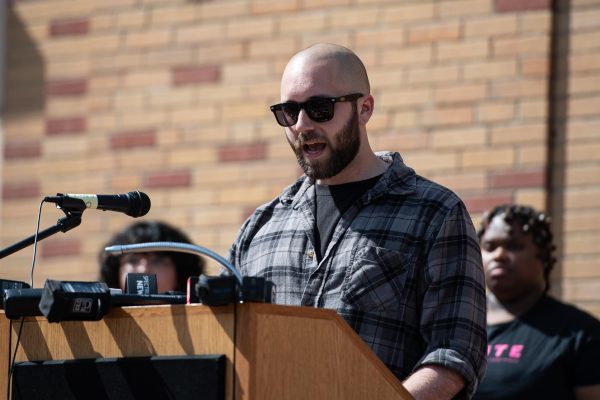Ohio to pool resources with Pa. for ‘Tech Belt’
December 3, 2007
While the Browns and Steelers fight for first place, Cleveland and Pittsburgh’s medical communities are forming an alliance to make themselves number one.
Reps. Tim Ryan, D-Ohio, and Jason Altmire, D-Pa., see pooling resources as the best way to capitalize on the burgeoning biotechnology industry.
“We think we’re missing opportunities,” Ryan said of possible investments that could be generated by the 700 bioscience companies in the “mega-region” of Cleveland, Akron, Youngstown and Pittsburgh.
Ryan estimates nearly $1 billon in health care research flows through Northeast Ohio and Western Pennsylvania each year.
Working together, institutions like The Cleveland Clinic and Pittsburgh’s Carnegie Mellon “create more value than they are creating alone,” Ryan said. “Venture capitalists (say) they are more inclined to help if (these companies) partner with each other.”
In April, Cleveland-based BioEnterprises Corp. and the Pittsburgh Life Sciences Greenhouse inspired the representatives by announcing an alliance that would collectively seek investments and share resources.
BioEnterprise’s founders and partners are The Cleveland Clinic, University Hospitals, Case Western Reserve University and Summa Health System.
Pittsburgh Life Sciences Greenhouse comprises Carnegie Mellon and the University of Pittsburgh, along with public and private investors..
Since the spring, Ryan and Altmire have promoted this team-up as the possible beginning of the “Tech Belt,” a name that recalls the auto industry’s Steel Belt of half a century ago.
As an acidic economy rusted the Steel Belt, Silicon Valley sprouted up in the Golden State.
Silicon Valley’s publicly held technology companies gained $2.5 billion in venture capital for 2007’s third quarter alone, according to SiliconValley.com.
In comparison, a summer MoneyTree Report showed that the entire venture capital investment for Life Sciences, which includes biotechnology and medical devices, during this year’s second quarter was $2.2 billion.
Ryan expects the Tech Belt’s success to depend on higher education. “Research institutions need to drive industry,” he said.
Stanford and UC Berkeley were essential in the genesis of Silicon Valley, home to Apple Inc., Intel and Google, along with 7,000 other companies.
Case Western and Carnegie Mellon are already well-established in biotech research, and Kent State, which is in Ryan’s district, also has much to contribute.
The Liquid Crystal Institute at Kent State has made breakthroughs harnessing lyotropic liquid crystals as Liquid Crystal Pharmaceuticals.
LCI partnered with Summa and IC-MedTech Inc. to develop the patent-pending Tolecine, an anti-tumor drug that “counteracts abnormal proliferation of cells in tissue or organ,” according to a press release.
“It takes both research and commercialization,” said Greg Wilson, associate vice president for economic development and strategic partnerships at Kent State, which works closely with LCI.
He credited Kent State’s biology department, NEOUCOMM, and local industry in the invention of biotechnology, such as LCPs and pathogen detection systems.
This research has directly led to the creation of new businesses Origen and Pathogen Systems Inc., Wilson said.
Wilson, who attended an autumn Tech Belt summit hosted by Ryan and Altmire at Youngstown State, said the LCI “helps propel the Tech Belt program by attracting more investors.”
Like Ryan, he had a positve outlook on the Tech Belt’s future.
“We are one of the leaders in bioscience investments,” he said, ranking the region in “the top tier” of bioscience research.
According to a BioEnterprise investment report, Cleveland’s $212 million in health-care related startup investments from January to September was second-best in the Midwest, falling just shy of Minneapolis’ $212.7 million. Add Pittsburgh’s $91 million, and the region has by far the strongest bioscience economy in the Midwest.
The interstate coalition still has a long way to go to compete with the 7,000-acre Research Triangle Park in North Carolina and 50 mile-long corridor along the pacific coast.
Ryan asserted that the federal government also has a role in this enterprise, and he has legislated on Capitol Hill to support growth in universities and small businesses.
Youngstown State has received almost $1.5 million in federal money for its Cyber Enabled Industrial Innovation Center and nanotechnology research.
He also proposed the Blue Collar Computing Bill and Business Assistance Act (H.R. 3466), which would provide funding for regional high-tech centers. These centers would serve as supercomputing hubs that smaller businesses could use to compete with industry leaders. The bill was last referred to the House Subcommittee on Energy and Air Quality.
Contact College of Technology reporter John Hitch at [email protected].























